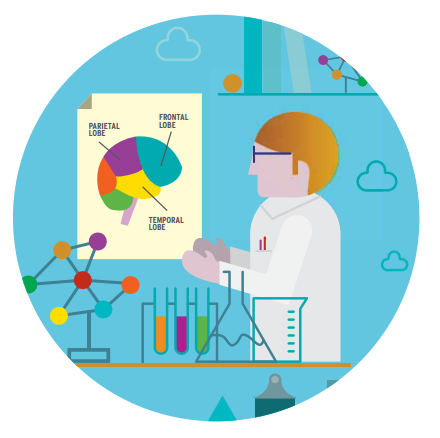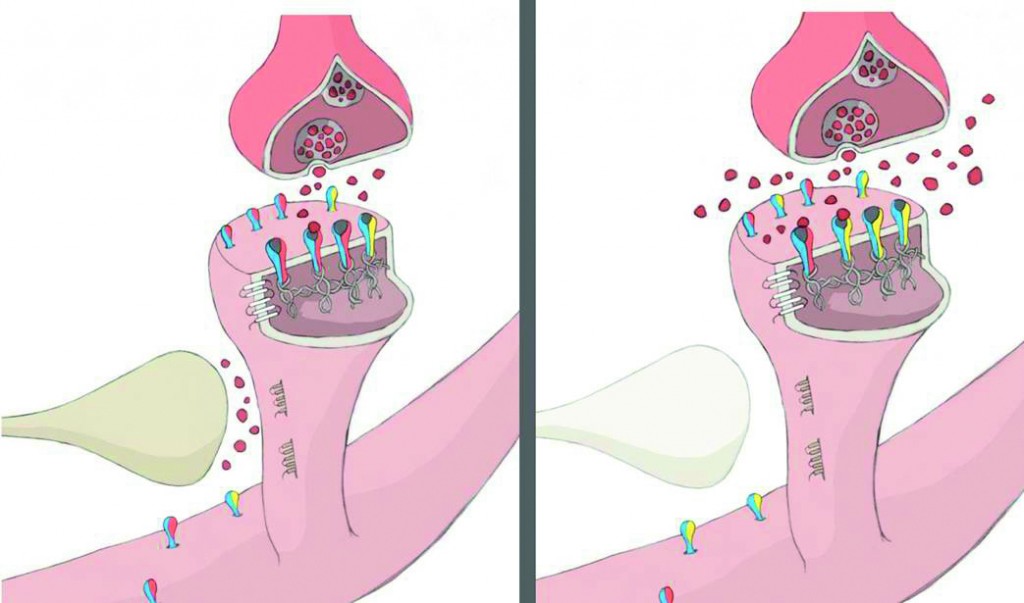People with Parkinson’s, scientists, advocates and politicians gathered in Paris in April for a two-day conference to discuss the results of the REPLACES project, a major five-year European Commission research initiative. TONY KIRBY reports the highlights of the conference, held at the state-of-the-art Institute of the Brain and Spinal Cord at the Salpêtrière Hospital
Launched five years ago with European Commission (EC) funding, REPLACES is a series of projects within a collaboration led by Professor Monica DiLuca of the University of Milan, Italy. The pioneering research programme aimed to advance understanding of key mechanisms involved in the development of Parkinson’s and move forward on finding new treatments for the disease and a cure. The EC provided €4.2 million for REPLACES as part of its Framework Programme 7 funding stream, a Europe-wide fund for the period 2007-13. Twelve organisations across eight European countries were involved.
REPLACES stands for REstorative PLasticity At Corticostriatal Excitatory Synapses. The project was based around the concept of “plasticity” in the neurons or nerve cells within the mid-brain that co-ordinate movement. The term plasticity refers to the ability of these cells to adapt to changes provided by different stimuli. As Parkinson’s progresses, this flexibility is gradually lost, and patients begin to experience motor and non-motor symptoms as their neurons deteriorate and die. The drug levodopa is routinely used to boost dopamine levels and so treat the motor symptoms of Parkinson’s. However, as the disease progresses, long-term use of levodopa can trigger involuntary movements in people with Parkinson’s (PwPs), a complication called dyskinesia.
New directions for science
Parkinson’s occurs when nerve cells become damaged or destroyed in the substantia nigra, the area of the mid-brain that produces dopamine. This neurotransmitter (chemical messenger) helps to regulate normal voluntary movement and co-ordination as well as a variety of non-motor functions. While research in previous decades has revealed the importance of dopamine in controlling movement, the REPLACES team realised more research was needed to understand its function more fully, especially in terms of how it interacts with other parts of the neurons.
To date, much Parkinson’s research has focused on reduced levels of dopamine in nerve cells, and the effects on motor function. The REPLACES team switched from focussing exclusively on dopamine to analysing other molecules which work together with dopamine, among them glutamate. This very important molecule acts closely with dopamine in helping to control motor functions. Professor DiLuca summarised its importance: “We believe that glutamate is responsible for regulating this peculiar feature of our neurons – plasticity – which is the capability of our neuronal connections to adapt to different stimuli and to respond to them with different strength.”
To understand the molecular and biological mechanisms involved, the overall aim of REPLACES was to describe the plasticity of the corticostriatal synapses, which means the flexibility of the neurons involved in motor control to respond and adjust to different levels of dopamine and glutamine. This involved a wide range of studies, from developing molecular models to analysis of the structure and workings of the basal ganglia (the region of the brain responsible for involuntary movements such as tremors).
“To reach our goal, REPLACES worked with multiple disciplines to tackle the same problem: understanding how dopamine and glutamate, by working with other transmitter molecules, work together to govern synaptic plasticity in the brain areas affected by Parkinson’s,” said Professor DiLuca. “The complete understanding of mechanisms regulating plasticity will hopefully lead to the design of new drugs and treatment approaches.”
Key achievements
So exactly how will REPLACES help people with Parkinson’s? The researchers made progress in three key areas, which led not only to new understanding of the disease, but also to the development of potential therapies that have already undergone preliminary testing in animal models.
The three key areas were:
The development of new cellular models and also animal models of Parkinson’s. This will allow scientists to reproduce the conditions associated with very early stages of the disease and to test diverse treatments.
A complete molecular description of the circuitry of the basal ganglia. This will help with the identification of critical molecular components involved in Parkinson’s, and present possibilities for the development of new treatment strategies.
The development of new drug treatments able to prevent and/or reduce the onset of involuntary movements (dyskinesia) caused by treatment with levodopa.
Going public
The first day of the REPLACES conference was all about science, with the various scientists involved sharing their detailed findings with the other experts. On the second day, Professor DiLuca and Professor Etienne Hirsch (Director of the Institute for Neuroscience, Cognitive Sciences, Neurology and Psychiatry at the French National Alliance for Life and Health Science), were part of a panel that addressed members of the public, including representatives from Parkinson’s patient organisations from across Europe.
Among the distinguished guests on the panel was Dr Mary Baker, president of the European Brain Council, who spoke about the importance of collaborations such as REPLACES, and the challenges facing Europe as its population ages. “Life is a journey, that we [are] prepared for by our parents, education, books, people we meet, but there’s a part of that journey no one prepares you for: a diagnosis of Parkinson’s disease,” she said. “A Parkinson’s diagnosis is a watershed, which leaves patients describing their life as ‘before I was diagnosed’ and ‘after I was diagnosed’. It makes a person feel they have lost control over their life, and none of us understands what that means until it happens to us.”
Dr Baker added that the way to give PwPs back control of their life was through “information, information, and more information”. She said: “There are people who have chosen to walk the journey with you: your doctors, and scientists that are part of this [REPLACES] and other Parkinson’s research projects. I had real pleasure in listening to the science behind REPLACES. The youth and enthusiasm of those involved will drive the research that will help your journey to get better.”
Also present was former Member of both the European Parliament and UK Parliament John Bowis, a long-time advocate of research and funding for Parkinson’s and other brain conditions. In a warmly received speech, Mr Bowis applauded the researchers and discussed the importance of brain research moving forward. He referred to the forthcoming delivery of the EC’s new Horizon 2020 research funding stream, and said that the €1 billion earmarked for health created enormous opportunities. In particular he referred to the Human Brain Project, which he believed would vastly increase our understanding of the brain.
Professor Yves Agid, co-founder of the Institute of the Brain and Spinal Cord in Paris, also addressed the audience, giving his impressions of the future of Parkinson’s research. He said that it was becoming clear that there were many (up to 30) subtypes of Parkinson’s, and that if different mechanisms were implicated in each, then the research community would have much work to do. He also stressed the importance of social science in the quest to treat the disease, giving the example of how couples can struggle to adapt when, for example, a person severely affected by Parkinson’s is given deep brain stimulation (DBS) therapy, and goes from being dependent on their partner to reasonably independent extremely quickly. Professor Agid added that “in the future, there could be multiple drugs to treat the various symptoms and effects of Parkinson’s”, and DBS could “progress to the point where it would only require stimulation from outside the skull, as opposed to the implanted electrodes currently used”.
Presenting the findings
Professor DiLuca thanked the EPDA for providing guidance and support to the REPLACES collaboration. She explained the concept of plasticity by likening it to the brain of a child that adapts and changes as it is bombarded with images, sounds, experiences and new information. “This function is maintained in adult life, and helps us deal with many activities including learning and motor functions,” she added. “Yet this plasticity, or flexibility, is altered or blocked in Parkinson’s.”
She acknowledged that today 1.2 million EU citizens have Parkinson’s. She reflected on the enormous emotional toll the disease exacts on PwPs, their carers and families. In terms of costs per case, Parkinson’s is one of the 12 most costly diseases in Europe. Half of the costs associated are indirect costs such as carer costs.
Professor DiLuca explained how, in Parkinson’s, brain cells in the substantia nigra start to malfunction. These cells, or neurons, play an important part in movement, as well as other functions such as addiction and reward. “An important molecule in this process is dopamine, which controls many aspects of Parkinson’s. There has therefore always been a strong focus on the dopamine system and the neural connections within it. But it is also now clear that dopamine is not giving all the answers, as we thought several years ago.”
Many PwPs are treated with levodopa to boost dopamine levels as they fall as the disease progresses. However, the function of the affected neurons is governed not only by dopamine, but also another molecule produced by the brain cortex, glutamine. When the input of dopamine changes during Parkinson’s, the structure and shape of neurons change, and the interaction with glutamate also changes. REPLACES research has highlighted the need to regulate levels of glutamine as well as dopamine, in order to keep the neurons functioning normally and provide effective treatment.
“As is well known, levodopa is an extremely effective treatment to boost dopamine levels, but how does it affect the communication between dopamine and glutamate?” asked Professor DiLuca. “Does replacing dopamine also ensure the correct balance between dopamine and glutamate is re-established?”
To answer these questions, the Swedish team in REPLACES designed a new small molecule that aimed to restore this correct balance within the neurons. The tests they carried out showed that this molecule reduced the occurrence of involuntary movements in animal models, and will now go on to further testing. Another technique developed by the REPLACES team attempts to restore the dopamine/glutamate balance and regulation from inside the neuron, by using a small peptide (a building block of protein) to rebalance the synapse (the junction between nerve cells). “This experiment was also a success,” DiLuca reported. “The peptide was able to work on the inner side of the neuron to rebalance it and reduce the occurrence of involuntary movements.”
A further achievement of REPLACES was a detailed investigation into a drug already used to treat Parkinson’s, pramipexole. This drug simulates dopamine receptors so that correct signalling can be maintained. REPLACES teams based in Sweden and Italy were able to discover the correct dose of this small molecule, which would enable signalling to be restored with less of the known side effects of this drug. Due to its effect on the reward centre in the brain, side effects may include compulsive behaviours such as gambling and shopping.
“We hope all of our results together can lead to more treatments for Parkinson’s disease very soon,” said Professor DiLuca.
Professor Hirsch added: “It was a great honour and pleasure to welcome the partners of the REPLACES consortium to the Institute of the Brain and Spinal Cord in Paris. Both the scientific and lay audience presentations were of high quality and I am sure that partners will continue to collaborate despite us reaching the end of the funding period; for instance, my group has developed in collaboration with the group of Dr Bjorklund in Sweden a completely new model of end-stage Parkinson’s disease. Such a model should help better predict the efficacy of treatment.” n
The REPLACES project is funded by the EU’s Seventh Framework Programme. For more information, visit www.replaces-pd.org.
Increasing glutamate to overcome disrupted dopaminergic function due to Parkinson’s
The diagram shows how the delivery of dopamine and glutamate in nerve cells is affected by Parkinson’s, as studied by the REPLACES team. The corticostriatal synapse of a healthy person is shown on the left (control). At the top, the glutamatergic terminal coming from the cortex releases glutamate, which interacts with its receptors (yellow/blue and red/blue areas). Below left, the dopaminergic terminal coming from the substantia nigra releases dopamine, which interacts with its receptors in the neck of the dendritic spine.
The panel on the right shows the corticostriatal synapse of a person with Parkinson’s. Dopamine is no longer released, while an increase of glutamate results in changes in the type, location, and number of glutamate receptors.
PARTNERS INVOLVED IN the REPLACES project
z
Lab. Neurophysiology, Santa Lucia Foundation, IRCCS, Rome
z
Leibniz-Institut für Neurobiologie
z
Institut National de la Santé et de la Recherche Médicale
z
Cardiff University
z
Lund University
z
Foundation For Applied Medical Research
z
University College London
z
Xigen SA
z
Centre National de la Recherche Scientifique
z
European Parkinson’s Disease Association (EPDA)
z
CF Consulting Finanziamenti Unione Europea Srl






0 Comments